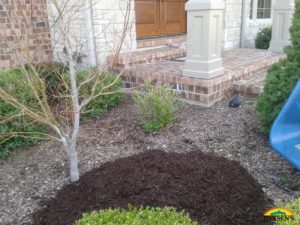Blog, Home Gardening Tips, Home Tree Care
Mulching 101: Applying the Correct Techniques
 With warmer weather finally upon us, many of our weekend chores will shift outdoors. As your grass turns green and your trees bloom back to life, the time for spring yard work has arrived.
With warmer weather finally upon us, many of our weekend chores will shift outdoors. As your grass turns green and your trees bloom back to life, the time for spring yard work has arrived.
And although you may feel like you have matters well in hand, there is one aspect of landscaping that is often overlooked or performed incorrectly: Mulching.
Spring mulching will help keep your trees healthy and give your yard a uniform look.
However, it is important to follow proper mulching techniques to avoid inadvertently causing greater health problems for your plants and trees.
The Benefits of Mulching
Aside from giving your yard consistency, mulch helps your trees and other plants in a variety of ways:
- Insulating the roots: Mulch keeps the soil cooler in the summer and warmer in the winter, which helps keep the roots of your trees at a stable temperature.
- Water management: By reducing evaporation, mulch helps keep your plants hydrated, which means you can cut down on watering.
- Weed prevention: A layer of mulch helps control the growth of weeds, which can sap the soil of its nutrients.
- Improved soil conditions: As organic mulch breaks down over time, it adds nutrients back to the soil. This recreates a more natural environment for your trees.
Additionally, mulch is a great way to recycle yard waste and can help protect your trees and garden from accidental hits by your lawnmower or weed whacker.
Common Mulching Mistakes
Mulch is a great way to help keep your lawn and gardens looking fresh, but it is important to remember that using improper techniques can lead to much greater problems. Common mulching mistakes include:
- Mulch volcanoes: The unfortunately common practice of over-mulching ends up looking like a volcano of mulch piled around the trunk leading to a variety of problems, such as oxygen starvation.
- Applying too early: Applying mulch too early in the fall or too early in spring can prevent the natural soil freezing and heating process. Wait until after a hard frost in the fall and the last hard frost of the spring.
- Always using the same mulch: Using the same mulch over and over can negatively affect the soil’s pH levels and nutrient composition.
When these improper mulching methods are applied, your tree can suffer from:
- Moisture or air barriers: Too thick of a much layer can cause issues allowing moisture to reach the roots or even trap too much. Additionally, you can block the flow of air to the soil.
- Root rot: Too much mulch around the base of a tree can lead to decay of the root collar or other insect and disease problems.
- Too much heat: When mulch decomposes, it generates heat. If you over-mulch, the heat from those extra layers can harm your tree.
Proper Mulching Techniques
While you may think mulching is as simple as buying a bag and dumping it around your tree, there are some basic mulching techniques that you should follow:
- Pick the right mulch: The mulch you find at your local landscape supply store will likely work for most applications, though some plants do better with specific types of mulch. Organic mulch is recommended for its soil-enhancing properties.
- Know how much you need: Remember to calculate how much mulch you actually need to prevent under-mulching or mulch waste.
- Keep mulch away from the base: Your mulch layer should start a few inches away from the root crown of the tree. Avoid piling mulch right up against the trunk.
- Mulch depth: You typically want to keep mulch 2-4 inches deep. Any more than that and you risk creating additional problems.
- Mix up the old mulch: If last year’s mulch is present, rake it around to check the depth and help aerate layers. Don’t simply pile more on top, since it may not even need it.
When you mulch properly, your trees and plants will greatly benefit from improved health, growing fuller and healthier. Happy mulching!
